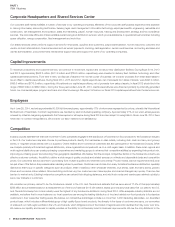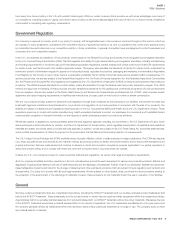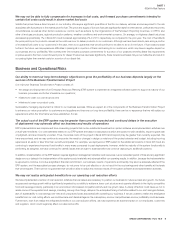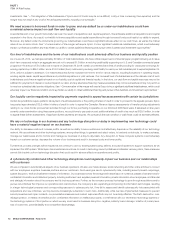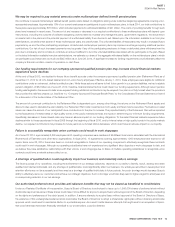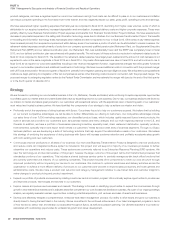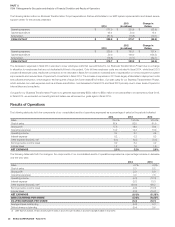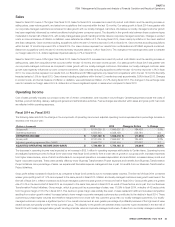Sysco 2014 Annual Report Download - page 25
Download and view the complete annual report
Please find page 25 of the 2014 Sysco annual report below. You can navigate through the pages in the report by either clicking on the pages listed below, or by using the keyword search tool below to find specific information within the annual report.SYSCO CORPORATION-Form10-K 13
PARTI
ITEM1ARisk Factors
We may be required to pay material amounts under multiemployer de ned bene t pension plans
We contribute to several multiemployer de ned bene t pension plans based on obligations arising under collective bargaining agreements covering union-
represented employees. Approximately 10% of our current employees are participants in such multiemployer plans. In scal 2014, our total contributions to
these plans were approximately $76 million, which included payments for withdrawal liabilities of $41 million. The costs of providing bene ts through such
plans have increased in recent years. The amount of any increase or decrease in our required contributions to these multiemployer plans will depend upon
many factors, including the outcome of collective bargaining, actions taken by trustees who manage the plans, government regulations, the actual return
on assets held in the plans and the potential payment of a withdrawal liability if we choose to exit. Based upon the information available to us from plan
administrators, we believe that several of these multiemployer plans are underfunded. The unfunded liabilities of these plans may result in increased future
payments by us and the other participating employers. Underfunded multiemployer pension plans may impose a surcharge requiring additional pension
contributions. Our risk of such increased payments may be greater if any of the participating employers in these underfunded plans withdraws from the
plan due to insolvency and is not able to contribute an amount suf cient to fund the unfunded liabilities associated with its participants in the plan. Based
on the latest information available from plan administrators, we estimate our share of the aggregate withdrawal liability on the multiemployer plans in which
we participate could have been as much as $245 million as of June 28, 2014. A signi cant increase to funding requirements could adversely affect the
company’s nancial condition, results of operations or cash ows.
Our funding requirements for our company-sponsored quali ed pension plan may increase should nancial markets
experience future declines
At the end of scal 2012, we decided to freeze future bene t accruals under the company-sponsored quali ed pension plan (Retirement Plan) as of
December 31, 2012 for all U.S.-based salaried and non-union hourly employees. Effective January 1, 2013, these employees were eligible for additional
contributions under an enhanced, de ned contribution plan. While these actions will serve to limit future growth in our pension liabilities, we had a sizable
pension obligation of $3.2 billion as of June 28, 2014; therefore, nancial market factors could impact our funding requirements. Although recent pension
funding relief legislation has served to defer some required funding, additional contributions may be required if our plan is not fully funded when the provisions
that provided the relief are phased out. See Note 14, “Company-Sponsored Employee Bene t Plans” to the Consolidated Financial Statements in Item 8
for a discussion of the funded status of the Retirement Plan.
The amount of our annual contribution to the Retirement Plan is dependent upon, among other things, the returns on the Retirement Plan’s assets and
discount rates used to calculate the plan’s liability. Our Retirement Plan holds investments in both equity and xed income securities. Fluctuations in asset
values can cause the amount of our anticipated future contributions to the plan to increase. The projected liability of the Retirement Plan will be impacted
by the uctuations of interest rates on high quality bonds in the public markets as these are inputs in determining our minimum funding requirements.
Speci cally, decreases in these interest rates may have an adverse impact on our funding obligations. To the extent nancial markets experience future
declines similar to those experienced in scal 2008 through the beginning of scal 2010, and/or interest rates on high quality bonds in the public markets
decline, our required contributions may increase for future years as our funded status decreases, which could have an adverse impact on our liquidity.
Failure to successfully renegotiate union contracts could result in work stoppages
As of June 28, 2014, approximately 8,800 employees at 52 operating companies were members of 59 different local unions associated with the International
Brotherhood of Teamsters and other labor organizations. In scal 2015, 13 agreements covering approximately 1,900 employees have expired or will
expire. Since June 28, 2014, there have been no contract renegotiations. Failure of our operating companies to effectively renegotiate these contracts
could result in work stoppages. Although our operating subsidiaries have not experienced any signi cant labor disputes or work stoppages to date, and
we believe they have satisfactory relationships with their unions, a work stoppage due to failure of multiple operating subsidiaries to renegotiate union
contracts could have a material adverse effect on us.
A shortage of quali ed labor could negatively impact our business and materially reduce earnings
The future success of our operations, including the achievement of our strategic objectives, depends on our ability to identify, recruit, develop and retain
quali ed and talented individuals, and any shortage of quali ed labor could signi cantly affect our business. Our employee recruitment, development and
retention efforts may not be successful and there may be a shortage of quali ed individuals in future periods. Any such shortage would decrease Sysco’s
ability to effectively serve our customers and achieve our strategic objectives. Such a shortage would also likely lead to higher wages for employees and
a corresponding reduction in our net earnings.
Our authorized preferred stock provides anti-takeover bene ts that may not be viewed as bene cial to stockholders
Under our Restated Certi cate of Incorporation, Sysco’s Board of Directors is authorized to issue up to 1,500,000 shares of preferred stock without
stockholder approval. Issuance of these shares could make it more dif cult for anyone to acquire Sysco without approval of the Board of Directors, depending
on the rights and preferences of the stock issued. In addition, if anyone attempts to acquire Sysco without approval of the Board of Directors of Sysco,
the existence of this undesignated preferred stock could allow the Board of Directors to adopt a shareholder rights plan without obtaining stockholder
approval, which could result in substantial dilution to a potential acquirer. As a result, hostile takeover attempts that might result in an acquisition of Sysco,
that could otherwise have been nancially bene cial to our stockholders, could be deterred.



